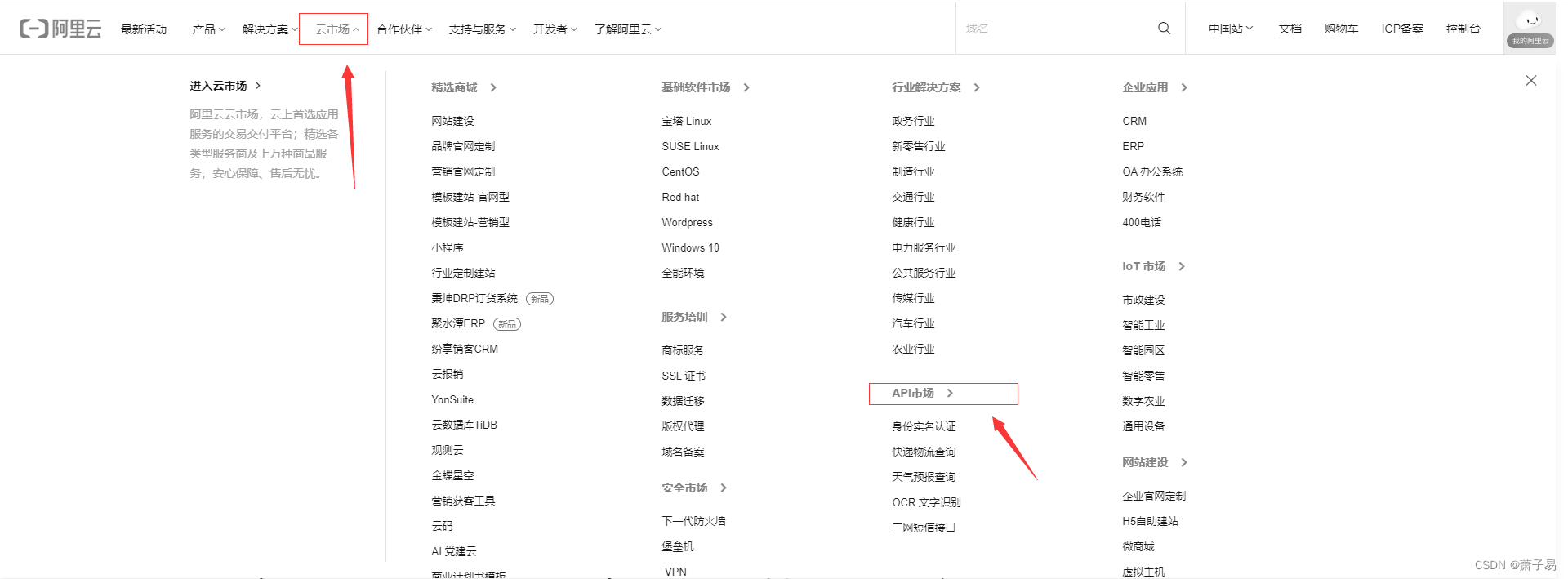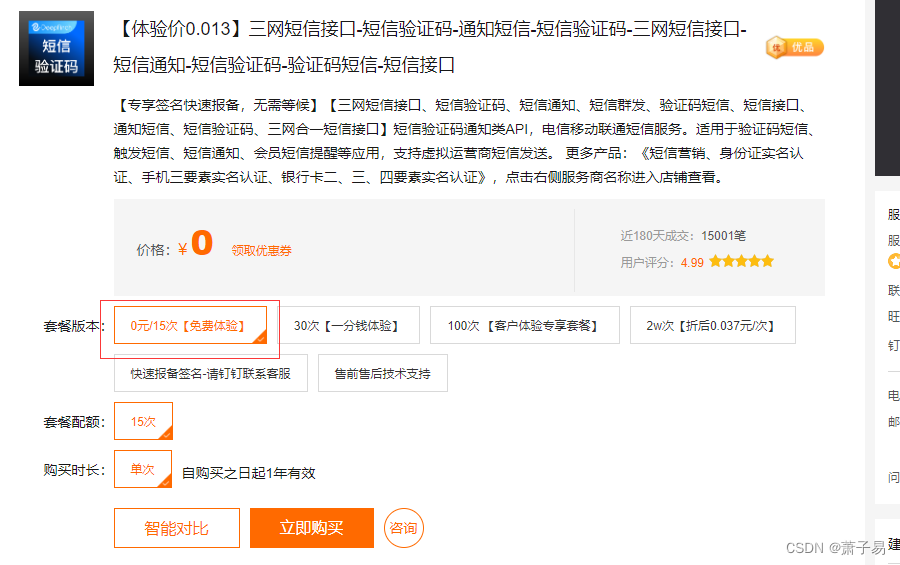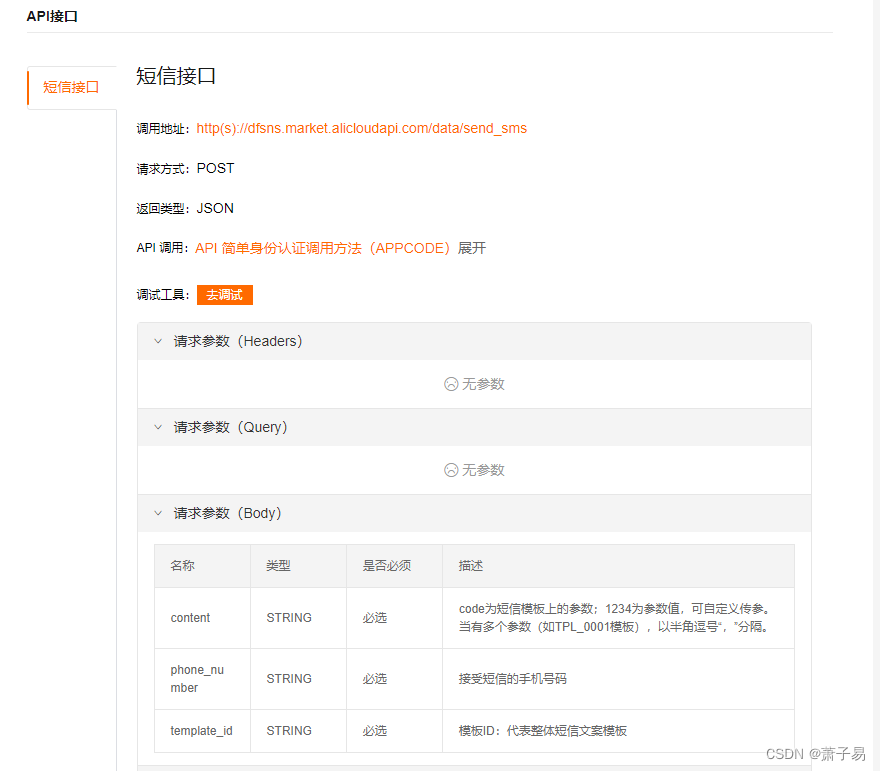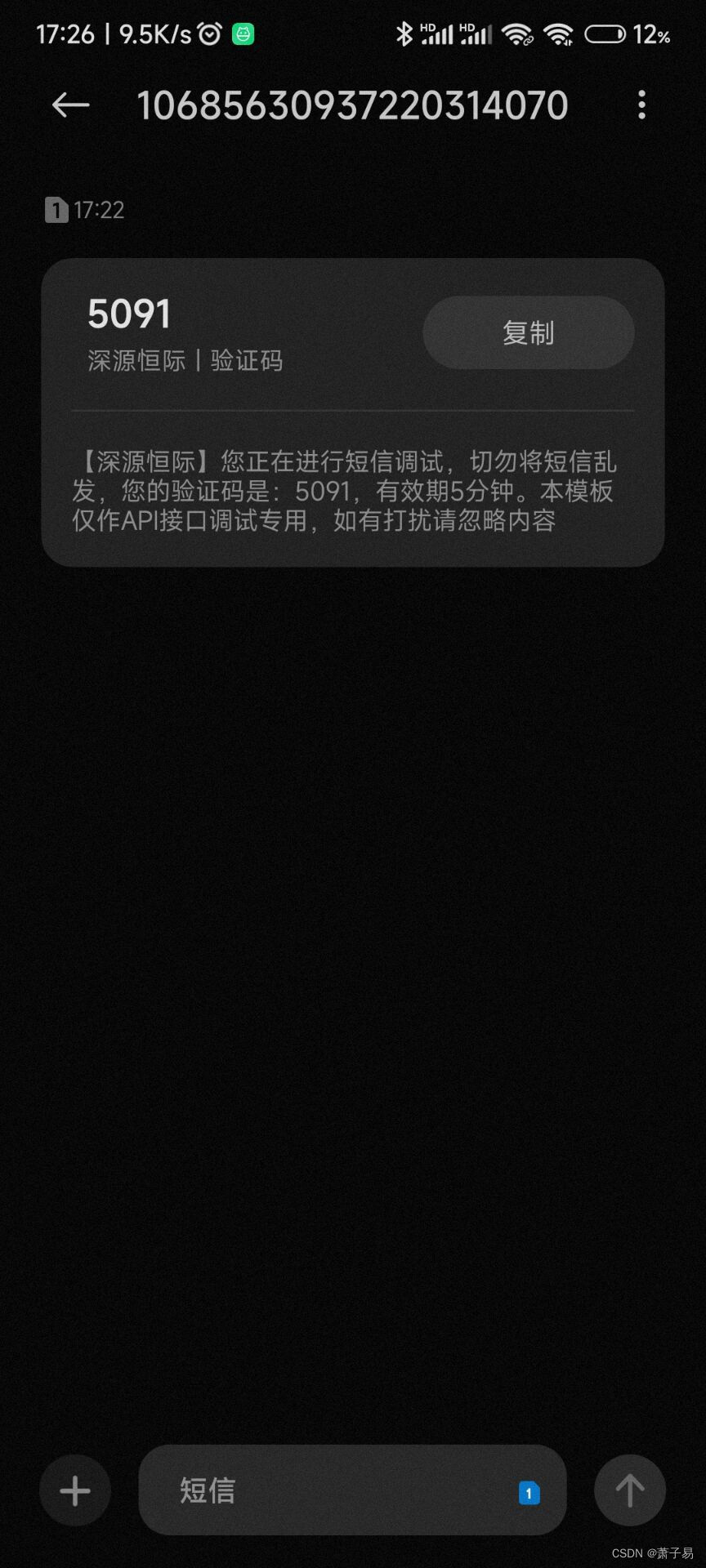Java实现短信发送
短信预约 -IT技能 免费直播动态提醒
首先,我们要实现Java短信发送功能需要去申请第三方短信接口,以阿里云为例
点击跳转

在API市场中找到短信验证码接口:

我们可以先选择免费试用来测试:

点击立即购买后可前往控制台查看:

OK,一切就绪后我们开始测试使用。
首先我们先回到商品详情页,在商品详情页下面,说明了这个接口的调用地址以及请求参数等:

接下来我们通过实例来调用接口进行测试:
1、加入相关依赖
具体可参考:相关依赖
<dependency><groupId>com.alibabagroupId><artifactId>fastjsonartifactId><version>1.2.15version>dependency> <dependency> <groupId>org.apache.httpcomponentsgroupId> <artifactId>httpclientartifactId> <version>4.2.1version> dependency> <dependency> <groupId>org.apache.httpcomponentsgroupId> <artifactId>httpcoreartifactId> <version>4.2.1version> dependency> <dependency> <groupId>commons-langgroupId> <artifactId>commons-langartifactId> <version>2.6version> dependency> <dependency> <groupId>org.eclipse.jettygroupId> <artifactId>jetty-utilartifactId> <version>9.3.7.v20160115version> dependency> <dependency> <groupId>junitgroupId> <artifactId>junitartifactId> <version>4.5version> <scope>testscope> dependency>2、创建HttpUtils.java类
HttpUtils.java类官方也已经帮我们封装好了,我们可以直接前往github下载,点击跳转
这里就直接把代码放上了
package com.aliyun.api.gateway.demo.util;import java.io.UnsupportedEncodingException;import java.net.URLEncoder;import java.security.KeyManagementException;import java.security.NoSuchAlgorithmException;import java.security.cert.X509Certificate;import java.util.ArrayList;import java.util.List;import java.util.Map;import javax.net.ssl.SSLContext;import javax.net.ssl.TrustManager;import javax.net.ssl.X509TrustManager;import org.apache.commons.lang.StringUtils;import org.apache.http.HttpResponse;import org.apache.http.NameValuePair;import org.apache.http.client.HttpClient;import org.apache.http.client.entity.UrlEncodedFormEntity;import org.apache.http.client.methods.HttpDelete;import org.apache.http.client.methods.HttpGet;import org.apache.http.client.methods.HttpPost;import org.apache.http.client.methods.HttpPut;import org.apache.http.conn.ClientConnectionManager;import org.apache.http.conn.scheme.Scheme;import org.apache.http.conn.scheme.SchemeRegistry;import org.apache.http.conn.ssl.SSLSocketFactory;import org.apache.http.entity.ByteArrayEntity;import org.apache.http.entity.StringEntity;import org.apache.http.impl.client.DefaultHttpClient;import org.apache.http.message.BasicNameValuePair;public class HttpUtils {public static HttpResponse doGet(String host, String path, String method, Map<String, String> headers, Map<String, String> querys) throws Exception { HttpClient httpClient = wrapClient(host); HttpGet request = new HttpGet(buildUrl(host, path, querys)); for (Map.Entry<String, String> e : headers.entrySet()) { request.addHeader(e.getKey(), e.getValue()); } return httpClient.execute(request); }public static HttpResponse doPost(String host, String path, String method, Map<String, String> headers, Map<String, String> querys, Map<String, String> bodys) throws Exception { HttpClient httpClient = wrapClient(host); HttpPost request = new HttpPost(buildUrl(host, path, querys)); for (Map.Entry<String, String> e : headers.entrySet()) { request.addHeader(e.getKey(), e.getValue()); } if (bodys != null) { List<NameValuePair> nameValuePairList = new ArrayList<NameValuePair>(); for (String key : bodys.keySet()) { nameValuePairList.add(new BasicNameValuePair(key, bodys.get(key))); } UrlEncodedFormEntity formEntity = new UrlEncodedFormEntity(nameValuePairList, "utf-8"); formEntity.setContentType("application/x-www-form-urlencoded; charset=UTF-8"); request.setEntity(formEntity); } return httpClient.execute(request); }public static HttpResponse doPost(String host, String path, String method, Map<String, String> headers, Map<String, String> querys, String body) throws Exception { HttpClient httpClient = wrapClient(host); HttpPost request = new HttpPost(buildUrl(host, path, querys)); for (Map.Entry<String, String> e : headers.entrySet()) { request.addHeader(e.getKey(), e.getValue()); } if (StringUtils.isNotBlank(body)) { request.setEntity(new StringEntity(body, "utf-8")); } return httpClient.execute(request); }public static HttpResponse doPost(String host, String path, String method, Map<String, String> headers, Map<String, String> querys, byte[] body) throws Exception { HttpClient httpClient = wrapClient(host); HttpPost request = new HttpPost(buildUrl(host, path, querys)); for (Map.Entry<String, String> e : headers.entrySet()) { request.addHeader(e.getKey(), e.getValue()); } if (body != null) { request.setEntity(new ByteArrayEntity(body)); } return httpClient.execute(request); }public static HttpResponse doPut(String host, String path, String method, Map<String, String> headers, Map<String, String> querys, String body) throws Exception { HttpClient httpClient = wrapClient(host); HttpPut request = new HttpPut(buildUrl(host, path, querys)); for (Map.Entry<String, String> e : headers.entrySet()) { request.addHeader(e.getKey(), e.getValue()); } if (StringUtils.isNotBlank(body)) { request.setEntity(new StringEntity(body, "utf-8")); } return httpClient.execute(request); }public static HttpResponse doPut(String host, String path, String method, Map<String, String> headers, Map<String, String> querys, byte[] body) throws Exception { HttpClient httpClient = wrapClient(host); HttpPut request = new HttpPut(buildUrl(host, path, querys)); for (Map.Entry<String, String> e : headers.entrySet()) { request.addHeader(e.getKey(), e.getValue()); } if (body != null) { request.setEntity(new ByteArrayEntity(body)); } return httpClient.execute(request); }public static HttpResponse doDelete(String host, String path, String method, Map<String, String> headers, Map<String, String> querys) throws Exception { HttpClient httpClient = wrapClient(host); HttpDelete request = new HttpDelete(buildUrl(host, path, querys)); for (Map.Entry<String, String> e : headers.entrySet()) { request.addHeader(e.getKey(), e.getValue()); } return httpClient.execute(request); }private static String buildUrl(String host, String path, Map<String, String> querys) throws UnsupportedEncodingException { StringBuilder sbUrl = new StringBuilder(); sbUrl.append(host); if (!StringUtils.isBlank(path)) { sbUrl.append(path); } if (null != querys) { StringBuilder sbQuery = new StringBuilder(); for (Map.Entry<String, String> query : querys.entrySet()) { if (0 < sbQuery.length()) { sbQuery.append("&"); } if (StringUtils.isBlank(query.getKey()) && !StringUtils.isBlank(query.getValue())) { sbQuery.append(query.getValue()); } if (!StringUtils.isBlank(query.getKey())) { sbQuery.append(query.getKey()); if (!StringUtils.isBlank(query.getValue())) { sbQuery.append("="); sbQuery.append(URLEncoder.encode(query.getValue(), "utf-8")); } } } if (0 < sbQuery.length()) { sbUrl.append("?").append(sbQuery); } } return sbUrl.toString(); }private static HttpClient wrapClient(String host) {HttpClient httpClient = new DefaultHttpClient();if (host.startsWith("https://")) {sslClient(httpClient);}return httpClient;}private static void sslClient(HttpClient httpClient) { try { SSLContext ctx = SSLContext.getInstance("TLS"); X509TrustManager tm = new X509TrustManager() { public X509Certificate[] getAcceptedIssuers() { return null; } public void checkClientTrusted(X509Certificate[] xcs, String str) { } public void checkServerTrusted(X509Certificate[] xcs, String str) { } }; ctx.init(null, new TrustManager[] { tm }, null); SSLSocketFactory ssf = new SSLSocketFactory(ctx); ssf.setHostnameVerifier(SSLSocketFactory.ALLOW_ALL_HOSTNAME_VERIFIER); ClientConnectionManager ccm = httpClient.getConnectionManager(); SchemeRegistry registry = ccm.getSchemeRegistry(); registry.register(new Scheme("https", 443, ssf)); } catch (KeyManagementException ex) { throw new RuntimeException(ex); } catch (NoSuchAlgorithmException ex) { throw new RuntimeException(ex); } }}3、发送验证码
public static void main(String[] args) { //短信api调用地址 String host = "https://dfsns.market.alicloudapi.com"; //请求路径 String path = "/data/send_sms"; //请求方式 String method = "POST"; //appcode:自己的AppCode,可以在自己的控制台找到,是一串32位的字符串 String appcode = "14xfa0523x3s2fe8ep0u54te14c2w36ad"; Map<String, String> headers = new HashMap<String, String>(); //最后在header中的格式(中间是英文空格)为Authorization:APPCODE 83359fd73fe94948385f570e3c139105 headers.put("Authorization", "APPCODE " + appcode); //根据API的要求,定义相对应的Content-Type headers.put("Content-Type", "application/x-www-form-urlencoded; charset=UTF-8"); Map<String, String> querys = new HashMap<String, String>(); Map<String, String> bodys = new HashMap<String, String>(); //使用随机数生成4位验证码 StringBuilder stringBuilder = new StringBuilder(); for (int i = 0; i < 4; i++) { int randomNum = (int) (Math.random()*10); stringBuilder.append(randomNum); } String code = stringBuilder.toString(); //这里是要发送给用户的验证码,我们使用了随机数进行生成 bodys.put("content", "code:"+code); //这里是接受短信的手机号码,我们在实际开发时这里就不能写死了 bodys.put("phone_number", "176****5321"); //这里是发送短信的模板ID:代表整体短信文案模板 bodys.put("template_id", "TPL_0000"); try { HttpResponse response = HttpUtils.doPost(host, path, method, headers, querys, bodys); System.out.println(response.toString()); //获取response的body System.out.println(EntityUtils.toString(response.getEntity())); } catch (Exception e) { e.printStackTrace(); } }好的大功告成,我们可以看下控制台给我们的打印:

说明发送成功了。我们打开手机也可以看到发给我们的验证码

来源地址:https://blog.csdn.net/qq_45004609/article/details/128188964
免责声明:
① 本站未注明“稿件来源”的信息均来自网络整理。其文字、图片和音视频稿件的所属权归原作者所有。本站收集整理出于非商业性的教育和科研之目的,并不意味着本站赞同其观点或证实其内容的真实性。仅作为临时的测试数据,供内部测试之用。本站并未授权任何人以任何方式主动获取本站任何信息。
② 本站未注明“稿件来源”的临时测试数据将在测试完成后最终做删除处理。有问题或投稿请发送至: 邮箱/279061341@qq.com QQ/279061341















